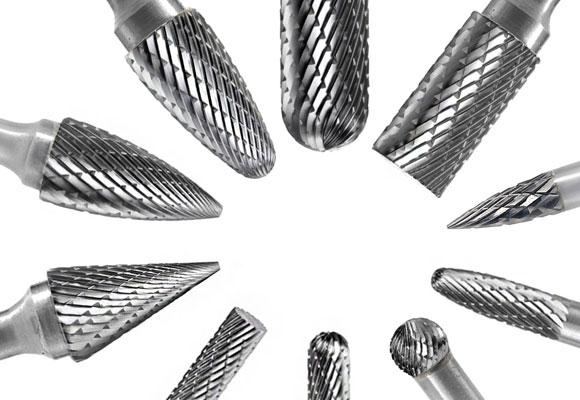
Carbide Burr Uses And Facts You Should Know
When it comes to deburring, grinding, cutting, or shaping various materials such as metal, plastic, and wood, carbide burrs are essential. Carbide burrs, or rotary files, come in different cuts and shapes designed for different jobs. If you’re planning to use carbide burrs in your project, here is some information you should keep in mind.

What are carbide burrs?
Carbide burrs, also known as rotary files or die grinder bits, are small spinning tools used to grind, cut, shape, and deburr (remove burrs, sharp edges, and unnecessary materials) a wide range of materials such as ferrous and non-ferrous metals, wood, ceramics, and plastics. They are frequently used by metalworking factories and equipment manufacturers to create smooth surfaces and complex designs, and remove superfluous materials. Rotary files are mainly used in rotary tools like die grinders, electric drills, and pneumatic grinders. Tungsten carbide is a crucial material to carbide burrs thanks to its outstanding hardness, wear resistance, and durability. With different shapes like inverted, ball, tree, etc, rotary files are suitable for different types of work, thus being preferred by many DIYers as well as professionals.
Carbide burr cuts
Carbide Burrs are typically offered in three variations: Single Cut carbide burrs, Double Cut (Diamond Cut) carbide burrs, and Aluminum Cut carbide burrs.


Single Cut carbide burrs
Single cut carbide burrs feature an up cut spiral flute. They are suitable for processing hard metals like copper, cast iron, steel, and brass, just to name a few. Single cut burrs have a variety of applications including milling, deburring, and cleaning.
Double Cut (Diamond Cut) carbide burrs
Double cut carbide burrs, also known as diamond cut burrs, are ideal for cutting soft metals and non-metal materials such as wood and plastics. With the cross cut design, double cut burrs are capable of efficiently creating a nicer finish surface than single cut carbide burrs. The applications of double cut burrs are fine finishing, cleaning, and deburring.
Aluminum Cut carbide burrs
Aluminum cut carbide burrs are specifically designed with a unique tooth geometry that is optimized for cutting through soft, non-ferrous metals like aluminum. The burrs have a flatter profile with wider flutes that help prevent clogging and allow for efficient material removal.
Carbide burr shapes
Carbide burrs come in various shapes, each designed for a specific purpose. Here are some frequently used carbide burr shapes:
Inverted Cone: The inverted cone-shaped burr has a narrow end and a wider base. It is used for carving and shaping hard materials.

Ball: The ball-shaped burr has a round end and is used for deburring and smoothing contoured surfaces.

Cylinder: This is a straight burr with a cylindrical shape. It is used for contouring and shaping surfaces.

Tree: This burr has a pointed end and a tapered shape. It is perfect for removing materials from narrow channels and inside corners.

Oval: The oval-shaped burr is used for smoothing and blending surfaces.

Flame: The flame-shaped burr has a tapered end and a rounded tip. It is useful for shaping and smoothing curved surfaces.

Carbide burr RPM
The rate of usage for the carbide burr in a rotary tool or die grinder is reliant on the contour and the processing material. However, because of safety concerns, the speed shouldn’t exceed 35,000 RPM. The table presented below provides approximate speeds.
| Diameter | RPM | |
| 1.6mm or 1/16″ | 25,000 – 35,000 | |
| 2.35mm or 3/32″ | 17,000 – 26,000 | |
| 3mm or 1/8″ | 17,000 – 26,000 | |
| 6mm or 1/4″ | 11,000 – 16,500 | |
| 12mm or 1/2″ | 8,000 – 12,000 | |
| 16mm or 5/8″ | 7,650 – 11,500 |
Carbide burrs vs. HSS burrs
Tungsten carbide is an extremely hard material compared to high speed steel (HSS). Therefore, carbide burrs are more suitable for finicky jobs. Besides, rotary burrs are more resistant to high temperatures, so they are capable of running hotter for a longer time.
Safety instruction
- It is essential to ensure that the burr shank is firmly inserted into the collet and clamped tightly.
- While focusing on the highest material first, apply gentle pressure and keep the burr moving.
- Make sure that your work is securely fastened to your workbench.
- Avoid snagging or jamming your burr into your workpiece.
- Minimum eye protection is essential, but it’s even better to use a full shield to cover your face.